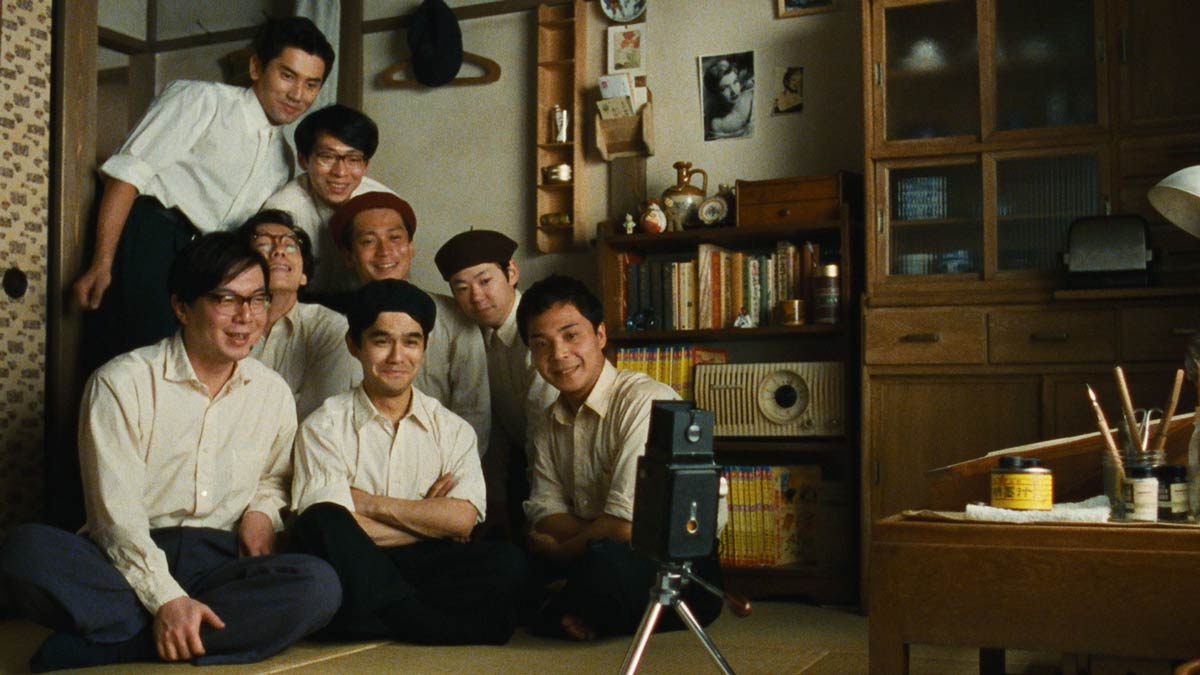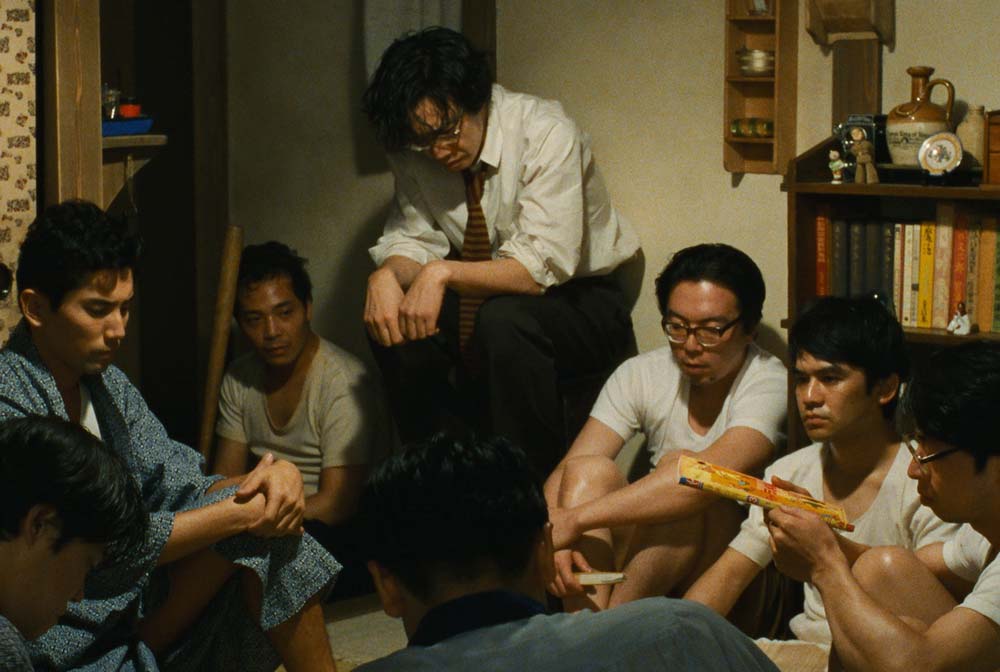
©1995/2020 Culture Entertainment Co., Ltd
"Tokiwa-so's Youth" The light and shadow of young manga artists drawn in a legendary apartment (Part 1/Planning part)
2021.02.12
Selected residents
Terada, who lives in the room opposite Tezuka, sees aspiring manga artists from all over the country constantly visiting Tezuka. And because he is so caring, he often ends up taking on the role of entertaining the young people in Tezuka's place when he is often away.
One of them was Motoo Abiko, also known as Fujiko F. Fujio A, who visited Tezuka's room in the early spring of 1954. Tezuka had urgent business to attend to, so after introducing Terada he disappeared, and Fujiko A met Terada for The Day After time. He stayed with them for a week, and eventually went to Tokyo with his partner Hiroshi Fujimoto, also known as Fujiko F. Fujio, and the two even discussed forming a group with Terada and the others, so they must have gotten along really well.
The two eventually moved to Tokyo and lived in a three-tatami room in Ryōgoku before moving into room 14 of Tokiwa-so after Tezuka had left on October 30, 1954. If the period when Kato, Tezuka, and Terada were there can be considered Tokiwa-so's "first period," then the period up to June 20, 1957, when Fujiko moved in and Terada left, could be called the "second period."
Following Fujiko, Shinichi Suzuki (room 20) became a resident on September 2, 1955, and Shotaro Ishinomori on May 4, 1956, with Fujio Akatsuka also moving into Ishinomori's room (room 17). Naoya Moriyasu also began sharing a room with Suzuki, and the second floor of Tokiwa-so came to be packed with as many as seven manga artists. All of them were members of the Shin Manga Party, which was founded by Terada, and their activities were centered around collaborations and monthly meetings.

“Tokiwa-so's Youth” ©1995/2020 Culture Entertainment Co., Ltd
The New Manga Party was founded on July 9, 1954, and the original members were not all familiar with each other. Terada called on new contributors to Manga Shonen who he thought had a similar style to him to form the group. According to Fujiko A, "the party was dissolved a year The Day After as a result of the parties clashing too much with each other's raw passion" ("Futari de Shonen Manga Yakari ga Kakuteite"), and in 1956 Suzuki, Ishinomori, and Tsunoda Jiro joined to form the Second New Manga Party, which was later joined by Akatsuka Fujio and, later, Sonoyama Shunji.
The activities of the Shin Manga Party and the increase in the number of manga artists living in Tokiwa-so were deliberately controlled. According to Fujiko and others,
"Terada Hiroo and I had an ambition to fill Tokiwa-so with young manga enthusiasts who shared the same aspirations, and Suzuki Shinichi was the first to make that happen." (Bungei Shunju, July 1977 issue)
This does not mean that anyone who wanted to be a manga artist was welcome, but also that only those who were recognized for their talent and joined the New Manga Party were able to move in. The obstacle to moving into Tokiwa-so was the 30,000 yen deposit, a large amount at the time. Not many could easily come up with the money. Fujiko was spared because Tezuka left his deposit intact, but Suzuki and Ishimori were able to move in thanks to Terada coming up with the 30,000 yen. This was made possible by Terada's desire to welcome them into the New Manga Party = Tokiwa-so.
Fujiko A.'s diary from that time records that when Ishinomori moved to Tokyo he expressed a desire to join the New Manga Party.
"We decided to take this opportunity to also get Tera-san and Tsunoda Jiro to join the party. We decided to include these two in the party. We decided to make the conditions for joining the party stricter in the future." ( Tokiwa-so Youth Diary )
Regarding the criteria for joining the New Manga Party, Terada says, "The rule was that everyone had to agree, and when we discussed who would be good to join, if someone opposed it or was negative because they didn't know much about it, we would think, "Well, we might as well stop for now... Basically, we wanted people who drew nice-looking manga and who seemed like people you could get along with" (Estria Quarterly Issue 2), as if the criteria were lenient, but was that really the case?
Later, when the era of weekly manga magazines began, Terada was relentlessly bullied by his editors about his ranking in popularity polls, and he became fed up with the fact that "both manga and magazines were becoming increasingly cruel" (ibid.), and he eventually dropped the series. It was a time when gekiga (dramatic comics) were flourishing, and they were beginning to have a major impact on children's manga as well. Terada, who believed that conscientious manga was necessary, found this unacceptable and sometimes took excessive action. Saito Takao, who was bringing a breath of fresh air to gekiga, remembers a letter he received from Terada.
"I got a letter out of the blue, telling me not to draw such vulgar things. It was a long lecture, about five pages long. Then later he sent me his book, like, "Look at this." Even though we'd never met." (" Manga Do Dai Kaibou ")
Based on this story, it seems that the conditions for joining the New Manga Party were not exactly lenient. In fact, when the two Fujiko members say in " Tokiwa-so Youth Diary " that "Joining the party was very difficult. If even one person opposed us, we couldn't get in," and "There were a lot of people who wanted to join," they were probably really feeling that way.
This cannot be simply condemned as sectarianism, since the fact that most of the members of the Shin Mangato later became successful must have been a reflection of Terada's strict aesthetic sense. The seedlings of the "Tokiwa-so myth" were planted by Tezuka Osamu, and it grew under the dedicated care of Terada Hiroo, bearing great fruit.

“Tokiwa-so's Youth” ©1995/2020 Culture Entertainment Co., Ltd
After Terada left in 1957, Tokiwa-so entered its "third period." From this point on, Shotaro Ishinomori became the central figure.
Mizuno Eiko (Room 19), who moved in in 1958, was summoned by Kodansha editor Maruyama Akira in order to collaborate with Ishinomori and Akatsuka, and the company arranged for her to rent a room for herself; she arrived by a clearly different route than previous manga artists, and did not join the New Manga Party. Around the same time, Takai Kenichiro, who had been told by Akatsuka and Ishinomori that there was a vacant room in Tokiwa-so, came to Tokyo, but "when I got there, I found that Mizuno Eiko had already taken the room I was supposed to take" (Manga Classroom), which caused some confusion. This was likely due to Terada's departure from control of the rooms.
Later, in 1958, Yokota Tokuo, an old friend of Ishinomori and Akatsuka, moved into Room 20, where Suzuki and Moriyasu had lived, and from 1960 to 1962, his assistant Yamauchi George and others lived in Room 18, which Ishinomori had rented as a work room. By 1961, Fujiko, Akatsuka, Ishinomori, and Yokota had all moved out, and only the assistants' rooms remained, marking the end of the lineage of Mangaso that began with Tezuka Osamu.
Looking at the history of Tokiwa-so over these three periods, we can see that its residents changed rapidly over time, and if the property were to be adapted into a film, the atmosphere of the film could change dramatically depending on which period and who is focused on.
In December 1955, Fujiko A's sister began living with the two Fujikos in Room 14 to take care of their meals, and early the following year, Fujiko F. moved into the neighboring Room 15, at the same time as calling for his mother, and Fujiko A's mother also began living with them at Tokiwa-so in 1958. Eventually, the two Fujikos rented a room in Usagi-so across the street as a workroom, and Tokiwa-so came to increasingly become a living space for the family.
The same was true for Ishinomori and Akatsuka. Initially, Akatsuka was living as a freeloader in Ishinomori's room, but soon after the neighboring room, Room 16, became available, so he moved out and eventually moved in with his mother. In 1960, he moved his workplace to the nearby newly built apartment, Shiunso (still standing), and it is believed that he also moved to Shiunso at this point.
Considering the separation of living space from the work room, and the fact that they lived together with their mothers, it becomes clear that the "communal living arrangement only for young manga artists" lasted only a very short period of time.
In "Tokiwa-so's Youth," Ichikawa Jun set the story from 1954, when Tezuka and Terada lived, to 1957, when Terada moved out, and incorporated some episodes from the time when Eiko Mizuno was a resident (1958). He then came up with the idea of making Hiroo Terada, who had been a supporting character in his previous works, the protagonist.

